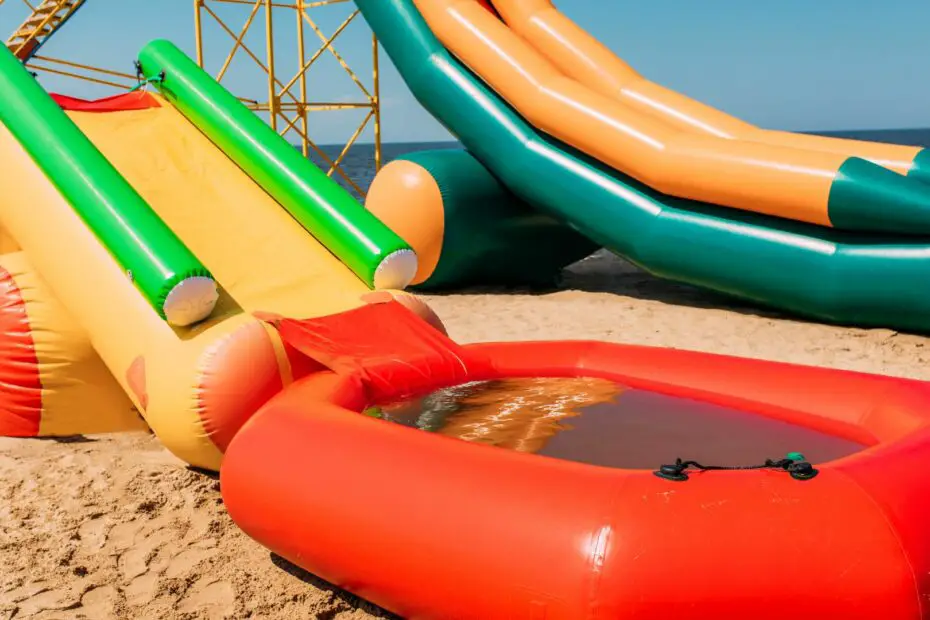Inflatables, whether they are hot tubs, boats, or toys, are popular for their portability and ease of use. However, a common problem faced by owners is water penetration. This can compromise the integrity and functionality of the inflatable. In this blog post, we’ll delve into the causes of water ingress in inflatables and offer solutions to tackle this issue.
Understanding the causes of water entering inflatables and how to prevent it is crucial for maintaining the longevity and safety of these items, whether they are for personal use or part of a larger commercial operation.
Common Causes of Water Entry in Inflatables:
- Material Damage: The primary reason for water entering inflatables is often due to physical damage, such as cracks or holes in the material. This damage can occur from wear and tear, over-stretching, or contact with sharp objects.
- Environmental Factors: Environmental conditions like wind and rain can also contribute to water entering inflatables. For instance, heavy rainfall can lead to water accumulation in areas where inflatables are not properly protected or sealed.
- Equipment Failure: In some cases, the problem might be due to equipment failure. For example, if an inflatable relies on a blower or airtight seals that malfunction, this can lead to deflation and water ingress.
Preventing Water Entry:
- Regular Inspection and Maintenance: Regularly inspecting inflatables for any signs of wear, tear, or damage and repairing them promptly is essential. Using repair kits correctly to cover any damage comprehensively can help prevent water entry.
- Proper Storage and Handling: Storing inflatables in a dry, covered area when not in use and ensuring they are not overstretched during use can significantly reduce the risk of water entry.
- Use of Protective Materials: In some cases, using rainproof fabrics or covers can help repel water and protect the inflatable from moisture-related damage.
- Environmental Awareness: Being aware of the environmental conditions, like avoiding setting up inflatables in areas prone to heavy rain or strong winds, is vital for preventing water damage.
- Equipment Checks: Ensuring that all equipment, such as blowers, is in good working order and suitable for the inflatable’s size and type is crucial for maintaining proper inflation and preventing water entry.
Drying and Recovery Post-Water Entry:
In cases where water has entered an inflatable, drying it out thoroughly is essential. This process involves removing surface moisture with towels and allowing the inflatable to dry completely in a space with good airflow. Outdoors is often the best option if the weather permits, as natural wind aids in drying. However, indoor spaces with fans or dehumidifiers can also be effective. The drying time can vary depending on several factors, including the size of the inflatable, ambient temperature, and airflow.
In summary, preventing water from entering inflatables involves a combination of careful maintenance, proper storage, environmental awareness, and the use of protective materials. Regular inspections and prompt repairs are key to ensuring that these inflatables remain dry and functional for their intended use.
Conclusion
Water entry in inflatables can be a nuisance, but understanding the causes and solutions can greatly extend the lifespan and enjoyment of these versatile products. Regular maintenance, careful use, and prompt repair of any damages are key to keeping your inflatables in top condition. By following these guidelines, you can ensure that your inflatable remains a reliable and enjoyable investment for years to come.
Stay informed and prepared for all your inflatable needs by subscribing to our blog for more tips and insights.
Frequently Asked Questions
Can all types of inflatables be repaired at home?
Minor damages in most inflatables can be repaired at home using repair kits, but complex or large-scale damages often require professional attention.
How often should I check my inflatable for leaks?
It’s advisable to inspect your inflatable before and after each use, especially if it’s exposed to harsh conditions or heavy use.
Are there any preventative coatings available to protect against leaks?
Yes, there are various protective coatings and sealants available that can be applied to extend the life and durability of inflatables.
Can UV exposure cause leaks in inflatables?
Prolonged UV exposure can degrade the material, increasing the risk of leaks. Using a UV protectant can help mitigate this risk.
Is it safe to use an inflatable with a slow leak?
While a slow leak might not pose immediate danger, it should be addressed promptly to avoid further damage or potential safety risks.



